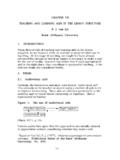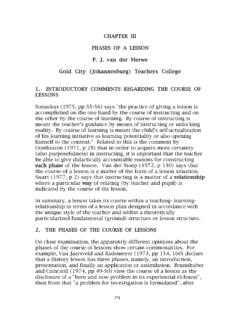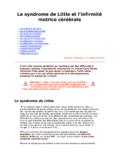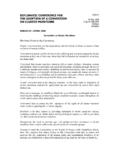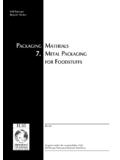Transcription of C H A P T E R 1 1 T H E W A R T E G G D R A W IN G M E D IU M
1 CHAPTER 11. THE WARTEGG DRAWING MEDIUM. 1. INTRODUCTION. This medium is based on the personality scheme of Sander that incorporates the following aspects: a) Emotions where there is a distinction between extrovertive and introvertive emotions;. b) Imagination where a distinction is made between combining and creative imagination. Combining imagination relies heavily on perception and, thus, on perceivable reality. Creative imagination is characterized by its loose relationships with perceivable reality and here imagination and fantasy are much more prominent;. c) Intellect, with respect to which there is a distinction between practical and speculative intelligence. Regarding practical intelligence, the perceptual also is more prominent and is paired with systematic thinking. Such a person is more oriented to a factual, concrete reality and to inductive reasoning.
2 The person whose intelligence is more speculative is attuned to principles rather than facts and he chooses theorizing practice; and d) Activity, which includes dynamic and controlled activity. The dynamic person is ready to explore; he is self-assured, venturesome and enthusiastic. He asserts himself readily in interpersonal relationships. The controlled person shows more stability in his actions and choices. He plans and thinks before he acts and later also reconsiders his choices. In general, such a person is more reliable and usually attains his goals. He prefers order and regularity and usually can, via adequate attending, take a position on a gnostic-cognitive level. However, his concentrated attending also can develop into fixations and his constant efforts into perseverations. The medium consists of eight numbered square spaces (of approximately 1 1/2 x 1 1/2 inches) on a piece of paper.
3 Numbers 1 to 4 are placed horizontally next to each other and numbers 5 to 8. are immediately beneath them. 195. In each square a little line, a dot, a dotted line, or a figure is introduced, each of which can be viewed as an incomplete drawing. According to Kinget (98, XIV) this medium has a series of qualities that gives it special merit as an exploratory medium. Some of these characteristics are directly relevant to its value as a diagnostic medium, others are of practical value but not of as much importance since the usability of a medium primarily is defined by them. This implies a combination of characteristics that are useful to the activities of the child and the investigator. The material, which is very unstructured, is presented to the child. The graphic marks that appear in the squares are very few in number and extremely simple; besides there is sufficient space around them in relation to their size.
4 For this reason a number of possibilities are offered the person for elaboration and expression. Although the medium confronts the child with unstructured material, it presents the orthopedagogic evaluator with highly structured material and furnishes him a number of criteria to objectively evaluate the child's "drawings". For example, relatively reliable indications can be found of the child's intelligence, the concrete or abstract direction of his thinking, his affectivity, his interests, his sociability, his artistic abilities, his motor skills. (see 174, 119). The child is provided with a medium-hard, sharp pencil and an eraser and the following instructions are given: "Here someone has begun to make eight drawings, one in each square but not one is completed. We don't know what he wanted to draw. Now you finish the drawing.
5 You can draw anything, and there are no right or wrong drawings. You can begin with any of the little drawings, perhaps the one you like most. You do not have to complete them in the same order that they are presented, and you can work as long as you want. However, you must not rotate the paper. Number your drawings in the order that you complete them.". The time it takes the child to complete the drawings is recorded in minutes. He then is asked to explain his drawings. Also, he is asked 196. if the marks remind him of anything other than what he has drawn and is asked about which drawings he likes best, likes least; which drawings were easiest and which most difficult to complete. 2. INTERPRETATION OF THE DRAWINGS. Although the child's drawings also are quantifiable for the purpose of interpretation, the orthopedagogic evaluator primarily takes a phenomenological view.
6 The following analytic aspects of the drawings serve as guidelines for evaluating the child's actualization of his psychic life. The investigator looks at his design as a particular view of him in reality. The abiding question is why this particular child has made this particular drawing. The results of the analysis also should only be interpreted as supplementary to those results obtained with the other media. There are three bases for interpreting the drawings, namely the relationship between the mark (as an appeal) and the drawing;. the content of the drawing; and the way the drawing is executed (see 98). _____. Analysis of drawings Aspects, responses to the appeal, and possible interpretations with reference to actualizing the psychic life Aspect A) THE RELATIONSHIP BETWEEN THE MARKS AND THE. DRAWING. Marks: 1. The dot: although its smallness makes it easy to ignore, because of its position in the exact center, it directs a clear appeal.
7 The child is confronted with the problem of discovering in the insignificant mark something of functional importance. Response to the appeal (dot): Sensitivity in series: attuned to affective- cognitive; relaxed disposition; emotionally stable; spontaneous; sense of detail; finicky- 197. Insensitivity in series: life-estrangement;. tension; insecurity; affectively blocked;. affectively labile; inattentiveness. 2. The wavy line: suggests something lively. Response to the appeal: Sensitivity in series: cognitive attunement;. 198. relaxed; favorable life relationships. Insensitivity in series: life-estrangement;. tension; insecurity; antagonistic; affectively blocked. 3. The three vertical regularly increasing lines: among other things, represent regularity, order, progression. Sensitivity in series: attuned to factual; more theoretical intelligence, can organize; good attending; firm; self-assured; affectively stable.
8 Insensitivity in series: unrealistically practically directed; inactive; inconsistent;. poor self-esteem. 4. The black square: appears solid and static and gives a somber, sometimes depressive impression. Sensitivity in series: factually attuned. Insensitivity in series: unrealistically practically directed. 5. The two opposed slanting lines: create the impression of conflict and dynamism and also suggest constructive or technical use. Sensitivity in series: factually attuned;. intelligence more theoretically directed; can organize; adequate attending; firm; vibrant;. competitive; ambitious. Insensitivity in series: unrealistically practically directed; inactive; inconsistent;. retiring; quiet. 6. The horizontal and vertical lines: the sober and strict horizontal and vertical lines confront the child with the problem to think about making a balanced whole of their eccentric positions.
9 Sensitivity in series: factually attuned;. intelligence more theoretically directed; can organize; adequate attending; firm; self- assured. Insensitivity in series: unrealistically practically directed; inactive; inconsistent;. poor self-esteem. 7. The dotted half circle: suggests something supple 199. and delicate. However, the child has to consider its position. Sensitivity in series: affective-cognitive disposition; intelligence more theoretically directed; can organize; relaxed; adequate attending; favorable live relationships; sense for details; finicky-precise. Insensitivity in series: life-estrangement;. inactive; tense; insecure; antagonistic;. inattentive. 8. The broadly curved line: has the quality of roundness and flexibility of number 7 (dotted half circle) but appears in addition restful, large, fluent and easy to deal with.
10 Sensitivity in series: affective disposition;. relaxed; favorable life relationships. Insensitivity in series: life-estrangement;. tense; insecure; antagonistic. B) THE CONTENT. 1. Scribblings a) General: Refer to an inadequate sensitivity to the appeal and an indifference to the task which he faces; labile affect; possible problems socializing because he doesn't try to satisfy reasonable standards. Unwilling to proceed to give meaning to the marks also refers to an unwillingness to explore and an inadequate distancing to the gnostic-cognitive level. b) Violent: Possibly weak muscle control; tension;. aggression; hostility; problems with interpersonal relationships. c) Mellow: More control over feelings and possible esthetic attunement. 2. Abstractions Where the general approach is decorative: the pathic- affective does not serve as an adequate foundation for gnostic-cognitive distancing; life tasks are avoided.
